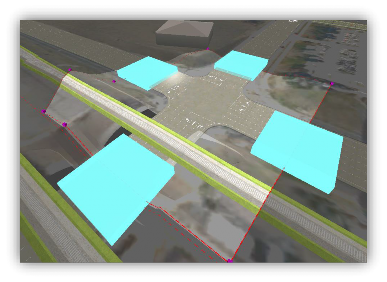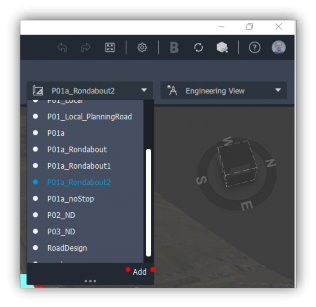& Construction

Integrated BIM tools, including Revit, AutoCAD, and Civil 3D
& Manufacturing

Professional CAD/CAM tools built on Inventor and AutoCAD
Any referenced datasets can be downloaded from "Module downloads" in the module overview.
Transcript
00:01
PRESENTER: Hi there.
00:03
In this video, we will explore potential solutions
00:05
to be considered for our roads and highways project.
00:10
This is where we are on the overall view
00:13
of the Analysis in Civil Engineering learning path.
00:17
Ideally, when starting to design different proposals
00:20
or solutions, we would base them on an original proposal that
00:24
already has all the data that we will
00:26
be comparing later on, such as the TSAs, or Traffic Study
00:31
Areas.
00:32
So [INAUDIBLE] traffic simulations and its TSAs
00:36
works between proposals.
00:38
At this point, you have most probably
00:40
noticed that you can not rename proposals,
00:44
but you can easily clone new ones
00:45
and delete the previous, if you have such a need.
00:48
Also, as you probably have already realized,
00:51
the TSAs are copied from one proposal
00:53
to the next one added, which is therefore
00:55
a clone with a different name that
00:57
includes the original proposals TSEs, if any.
01:03
Despite how a design may change, the demands
01:05
shouldn't, so we do want that information
01:08
to be transferred in order to avoid
01:10
typing it over and over again.
01:12
However, it is not possible to transfer TSAs directly
01:16
between existing proposals.
01:17
Is there any solution?
01:19
It is.
01:19
If it's too late, because you have
01:21
work done on different proposals,
01:23
you can try to merge them.
01:24
The action would transfer the TSAs plus all the data too.
01:28
However, you must be aware that this action could easily
01:31
lead into a corruption.
01:34
In example, PX01 has been created
01:37
based on a proposal that doesn't have TSAs.
01:40
And then, on the other hand, PY01
01:43
has been cloned from a proposal that has TSAs.
01:46
When merging PY01 into PX01, the TSAs will be displayed on PX01.
01:56
As we saw, the original P01 network proposal
01:59
shouldn't guarantee a decent traffic functionality,
02:02
and therefore, the roundabout alternative
02:04
was proposed, which made the solution fully functional.
02:09
That was an example of data driven design.
02:12
However, urban spatial planning is not only
02:15
having [INAUDIBLE] traffic, although, it
02:18
is an important factor.
02:20
Spatial planning is defined as the set of methods
02:23
able to influence and coordinate practices and policies
02:26
affecting the distribution of people and activities
02:29
in spaces most commonly within the cities.
02:33
Despite that the roundabout solution is a clear improvement
02:37
to the current arrangement, local authorities
02:39
are increasingly prioritizing and reviewing
02:42
environmental data, as well--
02:44
data, such as noise, pollution, wildlife, impact, et cetera.
02:49
In our case, after long consideration and a budget
02:52
boost, the authorities decided to give more importance
02:56
to green factors and consider a sustainable
02:59
proposal able to address both practical and environmental
03:03
requirements.
03:09
Here, the second design to consider.
03:13
This proposal adds a bridge that allows
03:16
to get rid of the busiest intersection,
03:19
and therefore, reduce both the noise and the pollution.
03:23
As the traffic simulation shows, this proposal
03:26
is also functional.
03:28
In order to add a bridge, a component road
03:31
required in first instance.
03:33
After that, the quantities of the bridge
03:36
can be easily checked using the structure's table.
03:39
The next proposal is the P03 one.
03:43
In this one, we have tried to meet all the local authorities
03:47
criteria and propose something that breaks
03:51
with the previous options.
03:53
I have switched the view to a conceptual one
03:56
so that you can feel the difference between the two.
04:00
The west roundabout is still there.
04:04
As it happened with the previous proposal,
04:06
this one has no freeways intersection.
04:10
And on top of that, one of the freeways
04:13
has been buried using a tunnel.
04:18
As you see, on the back, there is no railway
04:24
on the surface neither.
04:27
This space has been used to deploy a natural park
04:30
able to be used by wildlife.
04:37
Here are the railways, also buried, a little bit
04:42
above the freeway tunnel.
04:53
The P03 option, although it's altering
04:57
more of the surroundings, is clearly based on the P02 one.
05:01
And despite being much more expensive,
05:04
it meets all requirements for functionality
05:07
and sustainability asked by the local bureau.
05:12
Finally, we can run a traffic simulation
05:14
to verify that it is also functional.
05:17
But as you can imagine, it doesn't differ too much
05:21
from the P02 proposal.
00:01
PRESENTER: Hi there.
00:03
In this video, we will explore potential solutions
00:05
to be considered for our roads and highways project.
00:10
This is where we are on the overall view
00:13
of the Analysis in Civil Engineering learning path.
00:17
Ideally, when starting to design different proposals
00:20
or solutions, we would base them on an original proposal that
00:24
already has all the data that we will
00:26
be comparing later on, such as the TSAs, or Traffic Study
00:31
Areas.
00:32
So [INAUDIBLE] traffic simulations and its TSAs
00:36
works between proposals.
00:38
At this point, you have most probably
00:40
noticed that you can not rename proposals,
00:44
but you can easily clone new ones
00:45
and delete the previous, if you have such a need.
00:48
Also, as you probably have already realized,
00:51
the TSAs are copied from one proposal
00:53
to the next one added, which is therefore
00:55
a clone with a different name that
00:57
includes the original proposals TSEs, if any.
01:03
Despite how a design may change, the demands
01:05
shouldn't, so we do want that information
01:08
to be transferred in order to avoid
01:10
typing it over and over again.
01:12
However, it is not possible to transfer TSAs directly
01:16
between existing proposals.
01:17
Is there any solution?
01:19
It is.
01:19
If it's too late, because you have
01:21
work done on different proposals,
01:23
you can try to merge them.
01:24
The action would transfer the TSAs plus all the data too.
01:28
However, you must be aware that this action could easily
01:31
lead into a corruption.
01:34
In example, PX01 has been created
01:37
based on a proposal that doesn't have TSAs.
01:40
And then, on the other hand, PY01
01:43
has been cloned from a proposal that has TSAs.
01:46
When merging PY01 into PX01, the TSAs will be displayed on PX01.
01:56
As we saw, the original P01 network proposal
01:59
shouldn't guarantee a decent traffic functionality,
02:02
and therefore, the roundabout alternative
02:04
was proposed, which made the solution fully functional.
02:09
That was an example of data driven design.
02:12
However, urban spatial planning is not only
02:15
having [INAUDIBLE] traffic, although, it
02:18
is an important factor.
02:20
Spatial planning is defined as the set of methods
02:23
able to influence and coordinate practices and policies
02:26
affecting the distribution of people and activities
02:29
in spaces most commonly within the cities.
02:33
Despite that the roundabout solution is a clear improvement
02:37
to the current arrangement, local authorities
02:39
are increasingly prioritizing and reviewing
02:42
environmental data, as well--
02:44
data, such as noise, pollution, wildlife, impact, et cetera.
02:49
In our case, after long consideration and a budget
02:52
boost, the authorities decided to give more importance
02:56
to green factors and consider a sustainable
02:59
proposal able to address both practical and environmental
03:03
requirements.
03:09
Here, the second design to consider.
03:13
This proposal adds a bridge that allows
03:16
to get rid of the busiest intersection,
03:19
and therefore, reduce both the noise and the pollution.
03:23
As the traffic simulation shows, this proposal
03:26
is also functional.
03:28
In order to add a bridge, a component road
03:31
required in first instance.
03:33
After that, the quantities of the bridge
03:36
can be easily checked using the structure's table.
03:39
The next proposal is the P03 one.
03:43
In this one, we have tried to meet all the local authorities
03:47
criteria and propose something that breaks
03:51
with the previous options.
03:53
I have switched the view to a conceptual one
03:56
so that you can feel the difference between the two.
04:00
The west roundabout is still there.
04:04
As it happened with the previous proposal,
04:06
this one has no freeways intersection.
04:10
And on top of that, one of the freeways
04:13
has been buried using a tunnel.
04:18
As you see, on the back, there is no railway
04:24
on the surface neither.
04:27
This space has been used to deploy a natural park
04:30
able to be used by wildlife.
04:37
Here are the railways, also buried, a little bit
04:42
above the freeway tunnel.
04:53
The P03 option, although it's altering
04:57
more of the surroundings, is clearly based on the P02 one.
05:01
And despite being much more expensive,
05:04
it meets all requirements for functionality
05:07
and sustainability asked by the local bureau.
05:12
Finally, we can run a traffic simulation
05:14
to verify that it is also functional.
05:17
But as you can imagine, it doesn't differ too much
05:21
from the P02 proposal.


